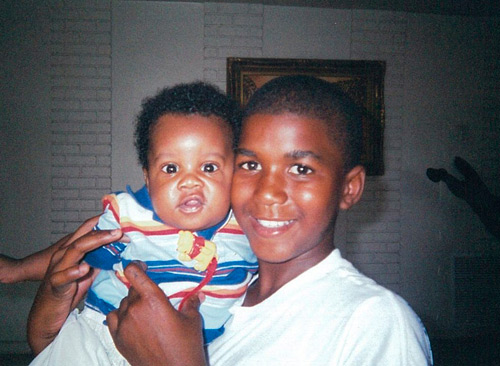Social media aids angst over Trayvon Martin case

In this undated photo provided by the Martin family, Trayvon Martin holds an unidentified baby. Martin, 17 of Miami Springs, Fla., was killed by a neighborhood watchman following an altercation in Sanford, Fla. as he walked from a convenience store in February, 2012.
ORLANDO, Fla. >> It started a couple of weeks ago with just a few cryptic messages on Twitter and other social media websites: Where is the justice? and R.I.P. Trayvon Martin.
A day later, nationally syndicated radio host Michael Baisden sent out a message to his 65,000 Twitter followers and 585,000 Facebook fans, adding a few details.
“Unarmed 17-year-old boy shot by neighborhood watch captain in Sanford, FL outside of Orlando,” the tweet said. It provided a Web link to a story.
Since then, hundreds of thousands of messages have spread the word about Trayvon Martin, a black teenager who was shot to death Feb. 26 by neighborhood watch volunteer George Zimmerman. Racial tensions have rapidly escalated as civil rights groups have held rallies, saying the shooting was unjustified.
Martin’s parents even started an online petition on Change.org demanding Zimmerman’s arrest. It had more than 1.2 million signatures.
Zimmerman claims self-defense, saying he shot Martin after being attacked by him. Zimmerman’s father is white and his mother is Peruvian.
Don't miss out on what's happening!
Stay in touch with breaking news, as it happens, conveniently in your email inbox. It's FREE!
Filmmakers Michael Moore and Spike Lee have also posted messages in support of Martin.
Martin, who lived in Miami, was in Sanford visiting family when he went to a convenience store. He was walking back carrying a bag of Skittles and can of iced tea, the hood of his jacket pulled over his head because it was raining that night. He was approached by Zimmerman, who told a police dispatcher he thought Martin looked suspicious. Zimmerman shot Martin following a chase and fight.
The online uproar became even greater after the first 911 tapes from the day of the shooting were released last week. In one of the calls, a dispatcher told Zimmerman to stop following Martin, but for some reason, he continued.
Twitter messages about Martin have been mentioned almost 600,000 times, according to the social media monitoring firm PeopleBrowsr. On Facebook, some protesters are wearing hoodies in their profile photos with the caption, “Do I look suspicious?”
Tracy Christensen, of Colorado, posted a message on the “Justice For Trayvon Martin” Facebook page, which had more than 50,000 “likes.”
“The entire country is behind you. Trayvon did not die in vain and he will not be forgotten. Justice will be served.”
She said it was the first time she used social media to take part in a protest.
“To bring nationwide, and perhaps worldwide attention to it so that the Justice (Department) and FBI get a move on,” she wrote. “Time is passing while a child murderer is walking free. Social media gives the people the power they never had before.”
The Justice Department and FBI have opened a civil rights investigation, and the local prosecutor has convened a grand jury April 10 to determine whether to charge Zimmerman.
Megan Lubin, a spokesman for Change.org, said the traffic on the Martin petition was one of their fastest-growing ever. The fastest was one asking for a “Caylee’s Law” in the aftermath of Casey Anthony’s acquittal by a central Florida jury for the killing her 2-year-old daughter Caylee. It received 1.3 million signatures and has led to bills requiring the quick reporting of missing children being introduced in state legislatures nationwide.
“What you’re seeing is that the Trayvon Martin case speaks to people around the country just like it speaks to people in this community,” NAACP president and CEO Benjamin Jealous said. “It would have been easy for people here to say ‘He wasn’t one of us. I didn’t know him. My kids didn’t go to school with him.’ But instead people here are saying what people said around the world, which is he reminds me of my cousin, of my son, or my grandson.”
Jeanette Castillo, an assistant professor of digital media at Florida State University, studied the Occupy Wall Street from a social media perspective and is also tracking the Martin case on Twitter.
She said the Martin case has played out in a protest era that will be increasingly driven by online audiences and their activism.
“You can hear about an issue in traditional media and be outraged. But in social media you have immediate feedback of how much your friends are outraged,” Castillo said. “It’s just a huge facet of social media that affects that mobilization. It’s sort of the same thing as word of mouth, but just at a lightning speed.”
Recent research by the Pew Research Center’s Internet & American Life Project shows why this case might be particularly resonating for the black Internet audience.
Aaron Smith, a senior researcher for Pew Internet, said a study updated last month shows that 15 percent of all Internet users nationally use Twitter, including 8 percent on a typical day.
White users are generally in line with the national average with 12 percent using the service or 7 percent on a typical day.
By contrast, black Internet users have very high rates of Twitter usage, with more than a quarter of them using Twitter overall and 13 percent of the black online population using Twitter on a typical day.
“It’s a bit different data than we’ve seen historically,” Smith said. “For a long time it was always digital divide story. But with social (media) we’re finding the black community on par with or ahead of their white counterparts with usage.”
———
Associated Press writer Suzette Laboy in Sanford contributed to this report.



